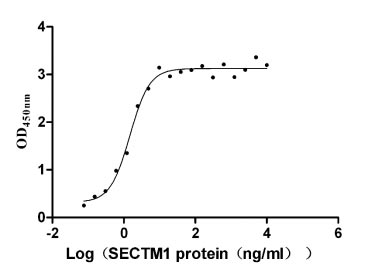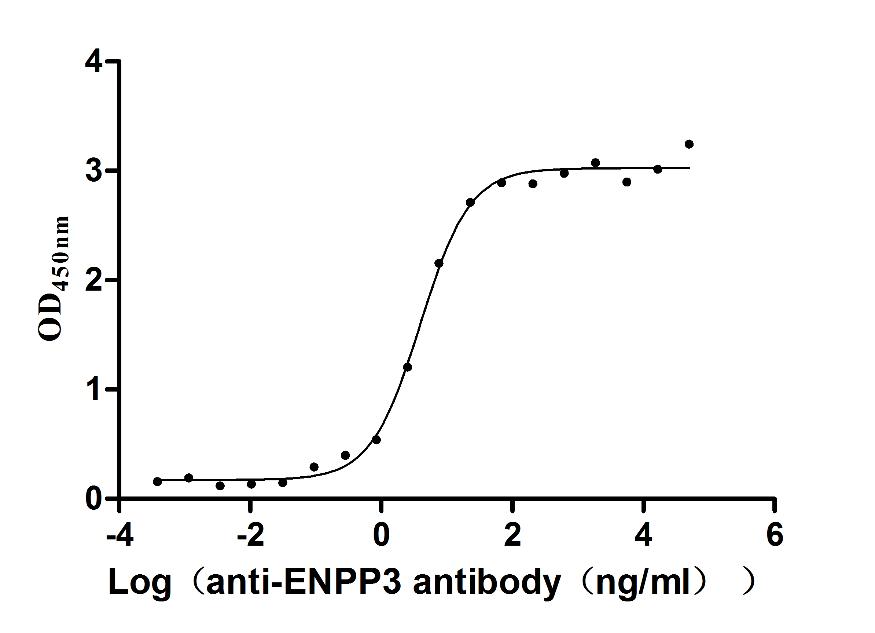Recombinant Mouse Vascular endothelial growth factor receptor 3 (Flt4), partial
-
货号:CSB-YP008735MO
-
规格:
-
来源:Yeast
-
其他:
-
货号:CSB-EP008735MO
-
规格:
-
来源:E.coli
-
其他:
-
货号:CSB-EP008735MO-B
-
规格:
-
来源:E.coli
-
共轭:Avi-tag Biotinylated
E. coli biotin ligase (BirA) is highly specific in covalently attaching biotin to the 15 amino acid AviTag peptide. This recombinant protein was biotinylated in vivo by AviTag-BirA technology, which method is BriA catalyzes amide linkage between the biotin and the specific lysine of the AviTag.
-
其他:
-
货号:CSB-BP008735MO
-
规格:
-
来源:Baculovirus
-
其他:
-
货号:CSB-MP008735MO
-
规格:
-
来源:Mammalian cell
-
其他:
产品详情
-
纯度:>85% (SDS-PAGE)
-
基因名:
-
Uniprot No.:
-
别名:Flt4; Flt-4; Vegfr3; Vascular endothelial growth factor receptor 3; VEGFR-3; EC 2.7.10.1; Fms-like tyrosine kinase 4; FLT-4; Tyrosine-protein kinase receptor FLT4
-
种属:Mus musculus (Mouse)
-
蛋白长度:Partial
-
蛋白标签:Tag type will be determined during the manufacturing process.
The tag type will be determined during production process. If you have specified tag type, please tell us and we will develop the specified tag preferentially. -
产品提供形式:Lyophilized powder
Note: We will preferentially ship the format that we have in stock, however, if you have any special requirement for the format, please remark your requirement when placing the order, we will prepare according to your demand. -
复溶:We recommend that this vial be briefly centrifuged prior to opening to bring the contents to the bottom. Please reconstitute protein in deionized sterile water to a concentration of 0.1-1.0 mg/mL.We recommend to add 5-50% of glycerol (final concentration) and aliquot for long-term storage at -20℃/-80℃. Our default final concentration of glycerol is 50%. Customers could use it as reference.
-
储存条件:Store at -20°C/-80°C upon receipt, aliquoting is necessary for mutiple use. Avoid repeated freeze-thaw cycles.
-
保质期:The shelf life is related to many factors, storage state, buffer ingredients, storage temperature and the stability of the protein itself.
Generally, the shelf life of liquid form is 6 months at -20°C/-80°C. The shelf life of lyophilized form is 12 months at -20°C/-80°C. -
货期:Delivery time may differ from different purchasing way or location, please kindly consult your local distributors for specific delivery time.Note: All of our proteins are default shipped with normal blue ice packs, if you request to ship with dry ice, please communicate with us in advance and extra fees will be charged.
-
注意事项:Repeated freezing and thawing is not recommended. Store working aliquots at 4°C for up to one week.
-
Datasheet :Please contact us to get it.
相关产品
靶点详情
-
功能:Tyrosine-protein kinase that acts as a cell-surface receptor for VEGFC and VEGFD, and plays an essential role in adult lymphangiogenesis and in the development of the vascular network and the cardiovascular system during embryonic development. Promotes proliferation, survival and migration of endothelial cells, and regulates angiogenic sprouting. Signaling by activated FLT4 leads to enhanced production of VEGFC, and to a lesser degree VEGFA, thereby creating a positive feedback loop that enhances FLT4 signaling. Modulates KDR signaling by forming heterodimers. Mediates activation of the MAPK1/ERK2, MAPK3/ERK1 signaling pathway, of MAPK8 and the JUN signaling pathway, and of the AKT1 signaling pathway. Phosphorylates SHC1. Mediates phosphorylation of PIK3R1, the regulatory subunit of phosphatidylinositol 3-kinase. Promotes phosphorylation of MAPK8 at 'Thr-183' and 'Tyr-185', and of AKT1 at 'Ser-473'.
-
基因功能参考文献:
- VEGFR3 has a role in lymphatic vessel hyperplasia through cell-autonomous and non-cell-autonomous mechanisms PMID: 29615616
- Fluid shear stress regulates vascular remodeling via VEGFR-3 activation, independently of its ligand, VEGF-C, in the uterus during pregnancy. PMID: 28849193
- Genetic depletion experiments revealed that VEGFR2, but not VEGFR3, is indispensable for maintenance of thyroid vascular integrity. Notably, blockade of VEGF-A or VEGFR2 not only abrogated vascular remodeling but also inhibited follicular hypertrophy, which led to the reduction of thyroid weights during goitrogenesis. PMID: 28438786
- Report the generation of a Vegfr3-CreER (T2) knockin mouse by gene targeting in embryonic stem cells. This mouse expresses the tamoxifen-inducible CreER(T2) recombinase under the endogenous transcriptional control of the Vegfr3 gene without altering its physiological expression or regulation in the lymphatic system. PMID: 26993803
- Lymphangiogenic growth in the diaphragm was highly dependent on vascular endothelial growth factor receptor (VEGFR)-3 signaling. During diaphragm development, macrophages appeared first in a linearly arranged pattern, followed by ingrowth of lymphatic vessels along these patterned lines. PMID: 27464987
- CLEC14A acts in vascular homeostasis by fine-tuning VEGFR-2 and VEGFR-3 signaling in endothelial cells PMID: 27991863
- VEGFR3 limits VEGFR2 expression and VEGF/VEGFR2 pathway activity in quiescent and angiogenic blood vascular endothelial cells, thereby preventing excessive vascular permeability. PMID: 28298294
- Blockade of FLT4 suppresses metastasis of melanoma cells by impaired lymphatic vessels. PMID: 27507214
- Vegf-d and its receptor Vegfr-3 were more highly expressed in lungs of hyperoxic, versus normoxic, wild-type mice, indicating that components of the Vegf-d signalling pathway are up-regulated in hyperoxia. PMID: 26924464
- this study uncovers a unique molecular mechanism of lymphangiogenesis in which galectin-8-dependent crosstalk among VEGF-C, podoplanin and integrin pathways plays a key role. PMID: 27066737
- Tnfsf15, a cytokine produced largely by endothelial cells, facilitates lymphangiogenesis by up-regulating Vegfr3 gene expression in LECs, contributing to the maintenance of the homeostasis of the circulatory system. PMID: 26096340
- Results showed that the VEGF-C/VEGFR-3 system underlies the protective effect of ischemic preconditioning against forebrain ischemia in the mouse hippocampus PMID: 25637798
- Experiments in mice and zebrafish demonstrate that changing levels of VEGFR3/Flt4 modulates aortic lumen diameter consistent with flow-dependent remodeling PMID: 25643397
- The VEGF-C/ VEGFR3 pathway is a positive signal that selectively promotes Neural stem cells activation and conversion into progenitor cells in mice. PMID: 25704818
- Lymphangiogenesis is induced by mycobacterial granulomas via vascular endothelial growth factor receptor-3 and supports systemic T-cell responses against mycobacterial antigen. PMID: 25597700
- Vascular endothelial growth factor C/VEGFR-3 signaling modifies HS and CCL21 gradients around lymphatics, regulating lymphocyte migration. PMID: 25606800
- found that VEGFR2 is required independently of VEGFR3 for endothelial DLL4 up-regulation and angiogenic sprouting, and for VEGFR3 functions in angiogenesis PMID: 25561555
- Leukemic environment is highly enriched with lymphangiogenic stimuli, and that VEGFR-3 inhibition restored NK cell killing function with an increased IFN-gamma level. PMID: 25157650
- reveal the evolutionary conservation of the lymphatic-like phenotype of the Schlemm's canal (SC), implicate VEGF-C and VEGFR-3 as critical regulators of SC lymphangiogenesis PMID: 25061878
- the role of short TRF2 as a preferential core promoter regulator. PMID: 25274728
- VEGF-C/VEGFR3 signaling plays an important role in the resolution of skin inflammation PMID: 24252749
- key role in preventing infections in macrophages PMID: 24656836
- VEGFR-3-mediated lymphangiogenesis thus appears to modulate the folliculogenic microenvironment. PMID: 24036251
- The cornea expresses a novel truncated isoform of this molecule, soluble VEGFR-3, which is critical for corneal alymphaticity and increase corneal transplant survival. PMID: 23476047
- Data suggest a regulatory role for VEGFR-3 in megakaryopoiesis. PMID: 22797697
- results establish that VEGFR2 and VEGFR3 are regulated in a highly differential manner by Notch; successful anti-angiogenic targeting of these receptors and their ligands will strongly depend on the status of endothelial Notch signalling PMID: 22426001
- Suggest that miR-1236 may function as a negative regulator of VEGFR-3 signaling during inflammatory lymphangiogenesis. PMID: 22223733
- Macrophage-derived VEGF-C activates VEGFR-3 in tip cells to reinforce Notch signalling, which contributes to the phenotypic conversion of endothelial cells at fusion points of vessel sprouts. PMID: 21909098
- role of NF-kappaB p50 in regulating the expression of VEGFR-3, Prox1 and lymphatic vessel density in mammary tissue, liver, and lung PMID: 21166921
- VEGFR3 activation by its cognate lignads (VEGFR-C/D)is only crucial to lymphangiogenesis but not required for angiogensis and blood vascular development by modulating VEGFR-2 mediated signals. PMID: 20697430
- systemic inhibition of VEGFR-3 increases inflammatory edema formation and inflammatory cell accumulation despite inhibition of lymphangiogenesis PMID: 20837699
- A VEGF-C-mediated mechanism plays an important role in the expansion of MALT lymphoma and the administration of Flt-4 antibodies had a suppressive effect on tumor growth. PMID: 20586849
- Cell adhesion to extracellular matrix induces a downstream signaling using the tyrosine kinase receptor VEGFR-3 as scaffold. PMID: 20431062
- CLP24 is a novel regulator of VEGFR-2 and VEGFR-3 signaling pathways and of normal lymphatic vessel structure PMID: 20439428
- VEGFR-3 participates in immune cell traffic from peripheral tissues to secondary lymphoid organs by regulating allograft lymphatic vessel CCL21 production PMID: 20231530
- A cooperative function of the three Ras proteins in normal development, and a novel aspect of VEGFR3 signalling modulated by Ras in lymphangiogenesis. PMID: 20179099
- interaction between neuropilin-2 and VEGFR3 mediates proper lymphatic vessel sprouting in response to VEGF-C. PMID: 20065093
- Prox1 synergizes with the p50 of NF-kappaB to control VEGFR-3 expression. PMID: 19901262
- Data suggest that VEGFR-3-specific signaling can induce new blood vessels, to which macrophages contribute a major role, and signify its potential as an additional therapeutic target to the existing antiangiogenesis strategies. PMID: 19808642
- result provides new insights into the involvement of vascular endothelial growth factor 3 signals in the maintenance of vascular integrity through modulation of vascular endothelial growth factor 2 signals PMID: 12393458
- In almost all monocytic-derived cells in conjunctiva. Might function as "trap" or functional "decoy" receptor by binding VEGF-C and VEGF-D growth factors to prevent lymphangiogenesis and angiogenesis into the cornea. PMID: 12614002
- Data demonstrate the expression of vascular endothelial growth factor receptor-3 and vascular endothelial growth factor-C on corneal dendritic cells, which implicate a potential relationship between lymphangiogenesis and leukocyte trafficking in the eye. PMID: 12819011
- VEGFR3 signaling is needed for lymph node metastasis in gastric cancer. PMID: 15072591
- hypoxia-driven vascular development requires the activity of VEGF receptor-3 PMID: 15466359
- Ang1 has a role in lymphatic vessel endothelial proliferation, Tie2 expression, and VEGFR-3 upregulation PMID: 15746084
- Blocking anti-VEGFR3 antibody significantly inhibited not only lymph- but also hemangiogenesis in mice with destrin-mutation in normally avascular cornea. PMID: 15855638
- VEGF receptor 3, normally present on lymphatic and proliferating blood vascular endothelium, is strongly constitutively expressed by corneal epithelium and is mechanistically responsible for suppressing inflammatory corneal angiogenesis PMID: 16849433
- cooperative signaling of VEGFR-2 and -3 is necessary for lymphatic migration and proliferation, but VEGFR-3 is redundant with VEGFR-2 for LEC organization into functional capillaries PMID: 17210781
- Spred1 and spred2 are essential for embrhyonic lymphangiogenesis by regulating VEGFR3 signaling. PMID: 17438136
- VEGFR-3 levels were not changed either in healthy or in diabetic muscle after the exercise training. PMID: 17766486
显示更多
收起更多
-
亚细胞定位:Cell membrane; Single-pass type I membrane protein. Cytoplasm. Nucleus. Note=Ligand-mediated autophosphorylation leads to rapid internalization.
-
蛋白家族:Protein kinase superfamily, Tyr protein kinase family, CSF-1/PDGF receptor subfamily
-
组织特异性:Expressed in adult lung and liver, and in fetal liver, brain, intestine and placenta.
-
数据库链接:
KEGG: mmu:14257
STRING: 10090.ENSMUSP00000020617
UniGene: Mm.3291
Most popular with customers
-
Recombinant Human T-cell antigen CD7 (CD7), partial (Active)
Express system: Mammalian cell
Species: Homo sapiens (Human)
-
Express system: Mammalian cell
Species: Macaca fascicularis (Crab-eating macaque) (Cynomolgus monkey)
-
Recombinant Macaca fascicularis CD93 molecule (CD93), partial (Active)
Express system: Mammalian cell
Species: Macaca fascicularis (Crab-eating macaque) (Cynomolgus monkey)
-
Express system: Mammalian cell
Species: Homo sapiens (Human)
-
Recombinant Mouse Gastric inhibitory polypeptide receptor (Gipr), partial (Active)
Express system: Mammalian cell
Species: Mus musculus (Mouse)
-


















